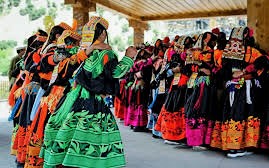Chitral (Pashto/Urdu: چترال, romanized: ćitrāl; Khowar: چھترار, romanized: ćhitrār, lit. 'field') is a town arranged on the Chitral River in northern Khyber Pakhtunkhwa, Pakistan. It fills in as the capital of the Chitral District and similarly filled in as the capital of the Chitral royal express that enveloped the area until its immediate joining into West Pakistan in 1947.
HISTORY
Chitral has been passed on undisturbed by intruders because of its area high up in the Hindu Kush. The Lowari Pass, in excess of 10,000 feet high, is the most minimal pass that leads into Chitral. No military has entered the district by the way from Jalalabad that goes up the Kunar River since it gets excessively restricted underneath Ashret. Consequently, endeavors to attack Chitral finished in disappointment.
In more seasoned times, Chitral was known by the name of Kashkar. The foot of the Hindu Kush was the home of the genies. It is said that the genie who took the ring of Hazrat Suleiman lived on Terich Mir and had his posts on numerous high mountains. Around then, timberlands and fields overwhelmed the scene. The genies utilized the grounds to rehearse drill and preparing works out. Indeed, even today, the individuals who go into the timberland actually hear the sound of march and symphony. The fables of Chitral is for the most part about pixies and genies, and about Hakeem Luqman, the Greek, whose name is related with fix.
BEAUTIFUL SITES
Teacher Dani of the University of Peshawar instituted the term, 'Gandhara Grave Culture' in the mid 1960s when he unearthed the internment site at Timargarha in Dir District and Thana in Swat. Today, the name is utilized concerning the pre-and proto-notable graveyard locales that were investigated nearby antiquated Gandhara, the easternmost region of the Persian Empire. These entombment date back to 1800 and 600 B.C, (as indicated by Dani) and have a place with the Aryans, these locales altogether unfurl the idea of prehistoric studies and change throughout the long term. To be sure, a cautious investigation of things, for example, the stoneware and instruments, the grave development and the internment style highlight the progressions after some time.
One of the uncommon archeological undertakings in Chitral was directed in the sixties by the Italian Archeologist Professor Stacul and British Archeologists Bridget and Raymond Allchins. It was then that some light was shed on the Burials of Gandhara Grave Culture in the Lower Chitral. To be more exact, in 1969, Professor Stacul found that Chitral had some Gandharan Grave destinations. Field work, notwithstanding, has been of an unsuitable nature and not much has been distributed. Moreover, three artistic vessels from Ayun have been inspected by Professor Allchin (1970) with the end that they look like the earthenware found in the Gandharan Graves. Different researchers and voyagers as well, are certain about the presence of Buddhist landmarks in Chitral.
Destinations of a similar sort were found during the 1999 endeavor that was a teamed up endeavor with the University of Bradford. These came in to see with the assistance of neighborhood information on designs and graves nearby and field study. Ranchers were a significant wellspring of itemized neighborhood information Moreover, two kinds of locales were found in 2000 with Peter and Azra Meadows.
1. Destinations of Gandhara Grave Culture (Proto memorable Period)
2. Fortresses and settlement locales of the seventeenth nineteenth hundreds of years
What's more, there was one Megalithic Burial Site too.
At this large number of areas, a comparable example continues in grave development and the method of entombment. Enormous pieces of stone are utilized to make a rectangular cist grave). Merchandise, for example, earthenware are covered with the expired and the actual internments are either interments or incinerations. This proposes that they can be consigned to one social gathering.
The grave entombments are a huge disclosure in the area of paleohistory, and have fitted into the hole between the downfall of Indus Valley Civilization and the appearance of Achaemenian in 600 B.C .the revelation has additionally ut to uncertainty a few acknowledged thoughts, for example, the term, 'Gandhara Graves' on the grounds that absolutely never was Chitral a piece of Ancient Gandhara. An unearthing of the site would provide us with the date of the internments and give material to the Chitral Museum, which has been supported by the Government of NWFP.
CULTURE AND TRADITIONS
The way of life and social propensities for the Chitralis date back to antiquated times. Joint family framework is as yet the standard. The dad is viewed as the top of the family; the honor is given on the oldest child after his demise. Typically it so happens that while the dad is alive, all live respectively in a solitary house. After his demise, the property is separated and the children move with their families into places of their own. The most youthful child acquires all houses possessed by the dad. The oldest makes a house for him without help from anyone else. For this reason, he is given land and wood for development.
To remark on their homes, the main room of the house is looking like a corridor and is brought into different purposes. It is separated into parts and each part is used in an unexpected way. In the focal point of the room is a chimney, whose smoke escapes through an opening in the roof. Men sit to the right and ladies to the left of the chimney. The region at the rear of the male and the female living rooms is utilized as room. Wheat-flour, ghee, meat and milk are put away in basements.
The primary room likewise fills in as a kitchen. This is particularly commonsense throughout the colder time of year season when a similar fire is utilized to cook and warm individuals. Each relative sits on the seat allocated to him. The first or the most unmistakable seat in the male segment is involved by the top of the house. As a partner to it, the main female individual from the family (typically the oldest little girl in-regulation) sits on the most noticeable seat in the female segment and cooks for all. Different individuals additionally sit as per pecking order. When visited by a strict and otherworldly pioneer, the top of the family offers his seat to him. On the appearance of a visitor, all coals of the family get up from their seats to invite him. The visitor is given due regard and keeping in mind that seniors are talking, adolescents don't meddle.
They possibly shout out when posed an inquiry, and that also is replied with tolerability and regard. They don't snicker before their elderly folks. It is considered inappropriate to speak more loudly in tattle or regular talk. Concerning their dietary patterns, a wheat bread (chapatti) is passed around and all individuals present take a piece. The visitor starts this introduction to lunch. Little matters, such as washing hands before dinners or drinking water request delicacy, for permitting others an opportunity to wash hands or drink water before they do is a method for showing regard.
Chitralis love parties; delight is multiplied by the arrangement of music. The region has a rich melodic custom maybe in light of the fact that music isn't limited to a station or gathering. The rich and the conscious don't think about melodic gatherings or shows as a shame. Rather, the playing of instruments is a craftsmanship consigned to the first class. Melodic shows can be sorted out whenever of the year; simply contact any young society or social club. Music, today, is belittled by the rich while in more seasoned days, this was the occupation of the mehtur.
In the hours of the mehtur, every day sittings (nashist) were held at court. These can be compared to a gathering of higher social and political request, or a gathering of Parliament. The regarded individuals of the area, the first class, managerial specialists and social specialists addressing distant areas of Chitral made up the members. Going to this sitting was taken as a badge of extraordinary alliance with the mehtur.
'Maarka' was a kind of gathering where open conversations were hung on public issues and regulatory issues. Pundits and investigators gave their perspectives, which engaged the ears of the mehtur. Then, at that point, the mehtur posed inquiries on different public and territorial issues, which were replied by the member crowd. Then, at that point, followed a meeting wherein various issues and matters of significance were talked about with the mehtur and his viewpoint taken. Critical political choices were made and regulation drafted. The members designated each other with tricks and mind, and here and there, this advanced into an intriguing contention. These contentions continued in a figurative language and were delighted in by the two members and audience members. Cruel words were conveyed under the attire of amiability.
Such gatherings were additionally coordinated by the lead representatives. These were accentuated by rewards and evening gatherings. Food was served on decorative liners spread before all members. A major decorative spread was set for the mehtur. It was the custom that the mehtur sent a couple of pieces to those whom he needed to respect. The regarded expanded with satisfaction and offered his appreciation to the mehtur.
Frequently it so happened that the mehtur appropriated all food before him and ate nothing. The story goes that a basic natured rural was selected gatekeeper to the room where the gatherings occurred. When, for certain days, he saw the mehtur sitting hungry, he felt frustrated about him. The following day, he made a bread (chapatti) of corn, for this was what the future held him, and carried it covertly with him. At supper, the mehtur again dispersed his portion and ate nothing. Seeing this, the blameless gatekeeper began making signs, as though he needed to pass something on to the mehtur.
He needed to tell him not to stress, for he had carried a chapatti with him and that he could eat it easily when the others had left. Incapable to decipher these signs, the mehtur sent an individual to ask. At the point when the matter became visible, the blamelessness of the resident shocked everyone. The mehtur compensated him with prizes.
A comparable practice is followed at relationships. To pay tribute to the wedding visitors that show up with the Baraat (wedding parade), an exceptional dish is served at breakfast of the next day.








0 Comments